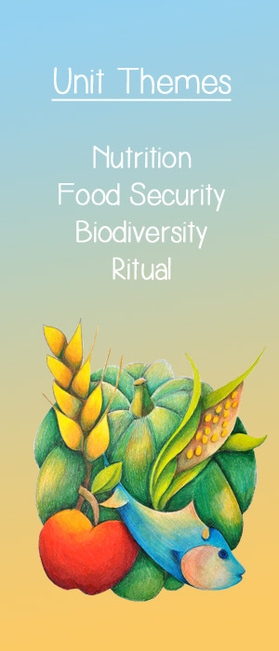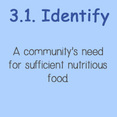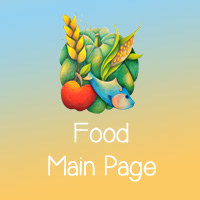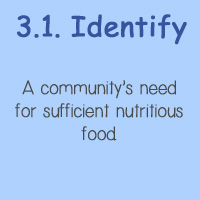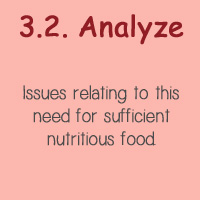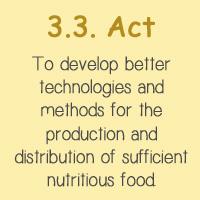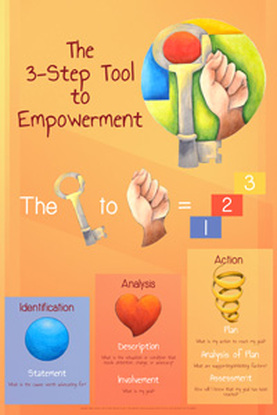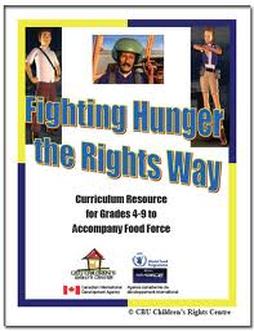"Hunger is the world's #1 health risk" (OneXOne)
Classroom Learning Activities
|
1. Identify a Community's Need for the Right to Food
Students refer to the 3-Step-Tool to Empowerment to identify a cause worth advocating for that relates to a community's right to sufficient nourishing food. This includes the following process:
|
Knowledge of rights guides the child to identify a cause worth advocating for.
|
|
2. Ensuring Food Secure Homes/Communities
There are many ways to feed our growing population so that all the worlds people can be food secure. These include:
|
The Hungry Season
(May 2012) Sea Monster and Leonie Joubert created this animated explainer film for The Open Society of South Africa, The Centre of Criminology and the Embassy of Finland. The explainer deals with three major issues around "Food Security" - Malnutrition, Poverty and Gender. |
|
3. Fighting Hunger the Rights Way
The activities in Fighting Hunger the Rights Way were designed to use the United Nations Convention on the Rights of the Child (UNCRC) as a framework for teaching students about malnutrition and related topics. Children’s rights are a fundamental theme in activities in this resource (e.g., viewing child malnutrition as a violation of children’s rights). It is important that students consider children’s rights when completing each activity (see pages 6-7 for more details regarding some of the specific rights focused on in this resource). It is also important for teachers to ensure that students keep an optimistic attitude when completing activities. Students should feel that youth can have a positive impact on their community, country and/or world.
The introductory activities should be completed prior to all other activities. Students will need to have a general understanding of the Convention on the Rights of the Child and World Food Programme’s (WFP) Food Force game in order to complete activities in Fighting Hunger the Rights Way. Students should be introduced to the Convention through the introductory activities in the Food Unit first, and then to Food Force, so that they may view child malnutrition as a violation of children’s rights and humanitarian aid as efforts to attain and adhere to children’s rights. |
Relevant Convention Articles
Article 6
1. States Parties recognize that every child has the inherent right to life.
2. States Parties shall ensure to the maximum extent possible the survival and development of the child.
Article 12
1. States Parties shall assure to the child who is capable of forming his or her own views the right to express those views freely in all matters affecting the child, the views of the child being given due weight in accordance with the age and maturity of the child.
2. For this purpose, the child shall in particular be provided the opportunity to be heard in any judicial and administrative proceedings affecting the child, either directly, or through a representative or an appropriate body, in a manner consistent with the procedural rules of national law.
Article 13
1. The child shall have the right to freedom of expression; this right shall include freedom to seek, receive and impart information and ideas of all kinds, regardless of frontiers, either orally, in writing or in print, in the form of art, or through any other media of the child's choice.
2. The exercise of this right may be subject to certain restrictions, but these shall only be such as are provided by law and are necessary:
(a) For respect of the rights or reputations of others; or
(b) For the protection of national security or of public order (ordre public), or of public health or morals.
Article 14
1. States Parties shall respect the right of the child to freedom of thought, conscience and religion.
2. States parties shall respect the rights and duties of the parents and, when applicable, legal guardians, to provide direction to the child in the exercise of his or her right in a manner consistent with the evolving capacities of the child.
3. Freedom to manifest one's religion or beliefs may be subject only to such limitations as are prescribed by law and are necessary to protect public safety, order, health or morals, or the fundamental rights and freedoms of others.
Article 15
1. States Parties recognize the rights of the child to freedom of association and to freedom of peaceful assembly.
2. No restrictions may be placed on the exercise of these rights other than those imposed in conformity with the law and which are necessary in a democratic society in the interests of national security or public safety, public order (ordre public), the protection of public health or morals or the protection of the rights and freedoms of others.
Article 24
1. States Parties recognize the right of the child to the enjoyment of the highest attainable standard of health and to facilities for the treatment of illness and rehabilitation of health. States Parties shall strive to ensure that no child is deprived of his or her right of access to such health care services.
2. States Parties shall pursue full implementation of this right and, in particular, shall take appropriate measures:
(a) To diminish infant and child mortality;
(b) To ensure the provision of necessary medical assistance and health care to all children with emphasis on the development of primary health care;
(c) To combat disease and malnutrition, including within the framework of primary health care, through, inter alia, the application of readily available technology and through the provision of adequate nutritious foods and clean drinking-water, taking into consideration the dangers and risks of environmental pollution;
(d) To ensure appropriate pre-natal and post-natal health care for mothers;
(e) To ensure that all segments of society, in particular parents and children, are informed, have access to education and are supported in the use of basic knowledge of child health and nutrition, the advantages of breastfeeding, hygiene and environmental sanitation and the prevention of accidents;
(f) To develop preventive health care, guidance for parents and family planning education and services.
3. States Parties shall take all effective and appropriate measures with a view to abolishing traditional practices prejudicial to the health of children.
4. States Parties undertake to promote and encourage international co-operation with a view to achieving progressively the full realization of the right recognized in the present article. In this regard, particular account shall be taken of the needs of developing countries.
1. States Parties recognize that every child has the inherent right to life.
2. States Parties shall ensure to the maximum extent possible the survival and development of the child.
Article 12
1. States Parties shall assure to the child who is capable of forming his or her own views the right to express those views freely in all matters affecting the child, the views of the child being given due weight in accordance with the age and maturity of the child.
2. For this purpose, the child shall in particular be provided the opportunity to be heard in any judicial and administrative proceedings affecting the child, either directly, or through a representative or an appropriate body, in a manner consistent with the procedural rules of national law.
Article 13
1. The child shall have the right to freedom of expression; this right shall include freedom to seek, receive and impart information and ideas of all kinds, regardless of frontiers, either orally, in writing or in print, in the form of art, or through any other media of the child's choice.
2. The exercise of this right may be subject to certain restrictions, but these shall only be such as are provided by law and are necessary:
(a) For respect of the rights or reputations of others; or
(b) For the protection of national security or of public order (ordre public), or of public health or morals.
Article 14
1. States Parties shall respect the right of the child to freedom of thought, conscience and religion.
2. States parties shall respect the rights and duties of the parents and, when applicable, legal guardians, to provide direction to the child in the exercise of his or her right in a manner consistent with the evolving capacities of the child.
3. Freedom to manifest one's religion or beliefs may be subject only to such limitations as are prescribed by law and are necessary to protect public safety, order, health or morals, or the fundamental rights and freedoms of others.
Article 15
1. States Parties recognize the rights of the child to freedom of association and to freedom of peaceful assembly.
2. No restrictions may be placed on the exercise of these rights other than those imposed in conformity with the law and which are necessary in a democratic society in the interests of national security or public safety, public order (ordre public), the protection of public health or morals or the protection of the rights and freedoms of others.
Article 24
1. States Parties recognize the right of the child to the enjoyment of the highest attainable standard of health and to facilities for the treatment of illness and rehabilitation of health. States Parties shall strive to ensure that no child is deprived of his or her right of access to such health care services.
2. States Parties shall pursue full implementation of this right and, in particular, shall take appropriate measures:
(a) To diminish infant and child mortality;
(b) To ensure the provision of necessary medical assistance and health care to all children with emphasis on the development of primary health care;
(c) To combat disease and malnutrition, including within the framework of primary health care, through, inter alia, the application of readily available technology and through the provision of adequate nutritious foods and clean drinking-water, taking into consideration the dangers and risks of environmental pollution;
(d) To ensure appropriate pre-natal and post-natal health care for mothers;
(e) To ensure that all segments of society, in particular parents and children, are informed, have access to education and are supported in the use of basic knowledge of child health and nutrition, the advantages of breastfeeding, hygiene and environmental sanitation and the prevention of accidents;
(f) To develop preventive health care, guidance for parents and family planning education and services.
3. States Parties shall take all effective and appropriate measures with a view to abolishing traditional practices prejudicial to the health of children.
4. States Parties undertake to promote and encourage international co-operation with a view to achieving progressively the full realization of the right recognized in the present article. In this regard, particular account shall be taken of the needs of developing countries.
Online Resources and References
- CitizenKid Central - Learn: Food Security
- Cool Foods Campaign
- Eat Well Guide
- Feeding 9 Billion
- Food, INC. by Robert Kenner and Eric Schlosser
- Humane Society
- Humanium Help the Children - Right to Food: Understanding children's right to food
- ONEXONE - Hope Belongs to Everyone: Hunger
- Plan - Planned Lifetime Advocacy Network
- The Good Garden - Food Security for Kids
- World Food Programme - Fighting Hunger Worldwide
- What's On My Food

